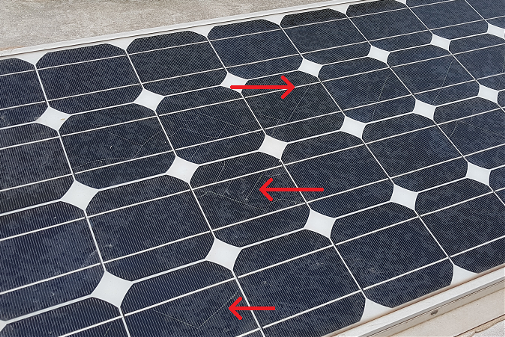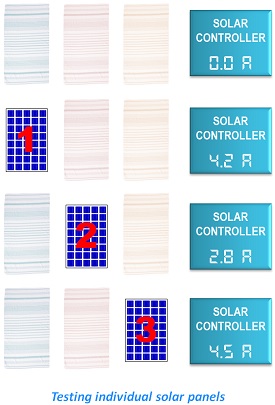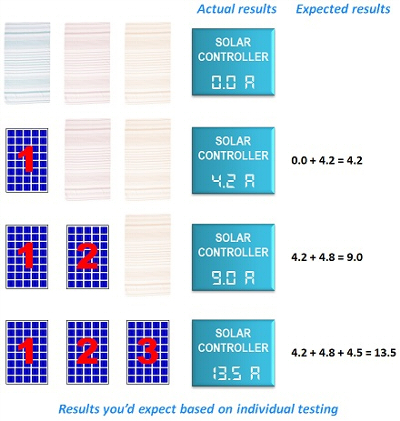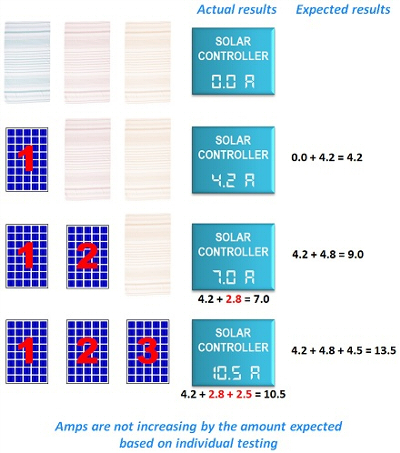Testing your solar panels
If you haven't got a multimeter, or you don't particularly want to get under each of the solar panels on your RV, there's another way to test the output of each panel using your solar controller.
The first step is to know how many amps you should be getting from each panel. To determine this, if it’s a nominal 12V panel, divide the watts by 18V (this is an average Vmp for a 12 volt panel) and this will give you the number of amps you should see coming out of the panel if it’s facing at a perfect angle to the sun. It will be less if your panels are lying flat on the roof, unless it is midday, full sun and you are in the upper northern areas of Australia.
So, for the purpose of this demo, let's say you have 100 watt panels and your RV is wired for 12 volt, you should get around 100W/18V Vmp = 5.56 amps from each panel, provided it’s not too hot.
What you'll need
- Old towels or blankets or something to cover each individual solar panel
- A good solar day, away from all shadow, including power lines and other things that may seem inconsequential.
- It will help to have someone inside to take readings
- Make sure you're not charging from mains, generator or DC to DC.
- You need the voltage of your battery to stay below 13V while you’re doing these tests, so you might need to turn something on in order to use some power. If the battery voltage climbs too high while testing, the solar controller will cut the number of amps to stop the battery from over voltage charging, and this will obviously affect your readings.
Some things to keep in mind when testing
- Each time you want to expose only one panel at a time
- Make sure there is no shadow over any panel, including shadows you might make when doing the testing.
- If a cloud comes over, you need to wait for it to go before continuing your readings
- While you're up there, take a look for dirt, shadow from aerials, vents, etc and damage such as chewed wiring or burns in the photovoltaic cells (they look like cracks):

Burns in photovoltaic cells
Testing individual panels
This test works best with a PWM solar controller, but it will work with an MPPT solar controller - just give the solar controller more time to settle so you can get a stable reading each time.
- Cover all your panels with the towels or blankets
- When all your panels are covered, remove one covering and take a reading in amps (A) of your solar input from your solar regulator, making a note of which panel you’re testing
- Cover that panel again, then remove the cover from another panel and take a reading again. Repeat until you’ve done them all.
- Add up all the readings and note any panel that is not putting out as much as the others, such as panel 2 in this example.

Testing the accumulated effect of each panel
OK, so let’s say you’ve now replaced solar panel 2 and individual testing shows it’s producing 4.8A (expected output would be 100W ÷ 18V (Vmp) = 5.5A, but that’s under standard test conditions).
The purpose of the following test of the accumulated effect of each panel is to know if your solar wiring and/or solar controller are sufficient for the amount of solar panels you have.
- Cover all your panels again.
- Now uncover panel 1 and take a reading from your solar controller. It should be 4.2, just like when you tested your panels individually, and it is. All good.
- Now leave panel 1 uncovered, and uncover panel 2 as well.
- Take a reading from your solar controller.
- You'd expect this reading to be 4.2A + 4.8A = 9.0A, and it is. Going well.
- Leave panels 1 and 2 uncovered and uncover panel 3.
- Take another reading.
- You would expect your reading to be 4.2A + 4.8A + 4.5A = 13.5A.
- If this is the reading you get, your system has passed muster and you're all done.

But what if your readings don't increase by the amount you expect each time you uncover an additional panel?

- Cover the first panel and see if the total amps on your solar controller drops by the amount you have recorded for that panel on its own, or was it the same amount as you gained when you uncovered the last panel?
- If the loss is only as much as the last panel uncovered, expose the first again and cover the last panel. If the amps are about the same, no matter which panel is covered, yet the total of all the individual output adds up to more than the combined total you get with all the panels uncovered, the problem is in the wiring size or the controller is too small for the job.


Our recommended cable sizes to connect multiple panels; extending that cabling to a junction box and from the junction box to your solar controller. We also look at the vagaries of MC4 connections and the need for circuit breakers so you can isolate your solar input.
A multimeter is an essential part of the RV owner's toolkit. We point out things to beware of and our favoured model.
We've put together a simple formula based on the advertised capacity of a solar panel, and other factors such as geography and time of year, so that you can work out how many amps your solar should be harvesting to charge your battery.
How to make the most of the solar panels you have, the huge impact that shadows have on your solar harvest, the importance of cleaning your panels and how to make that cleaning last.